The SanDisk Extreme PRO with USB4 is a high-performance portable SSD built for users who need fast transfer speeds in a compact, rugged design. While most external drives still operate on USB 3.2 Gen 2 or Gen 2×2 interfaces, this model jumps to USB4 Gen 3×2, pushing the theoretical ceiling to 40Gbps. It’s available in both 2TB and 4TB capacities. The SanDisk Extreme PRO SSD is aimed at professionals and power users who work with large files and high-bandwidth workflows, like 4K/8K video editing, real-time media access, or portable game storage.
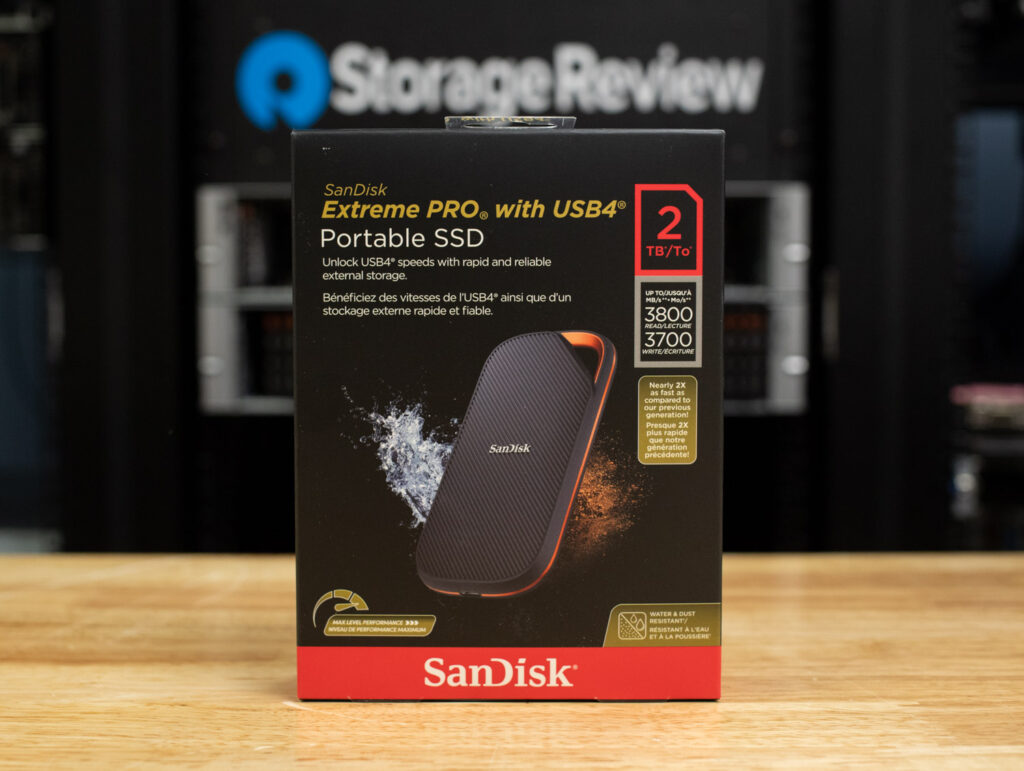
SanDisk Extreme PRO with USB4 Features
Positioned at the top end of SanDisk’s external drive lineup, the Extreme PRO USB4 sits above the more common Extreme and Extreme PRO Gen 2 models, offering a nice performance jump if you’ve got the hardware to take advantage of it. It’s one of the few USB4-native SSDs currently available, and while it comes at a premium, the specs and build quality suggest it’s aiming to justify that price.
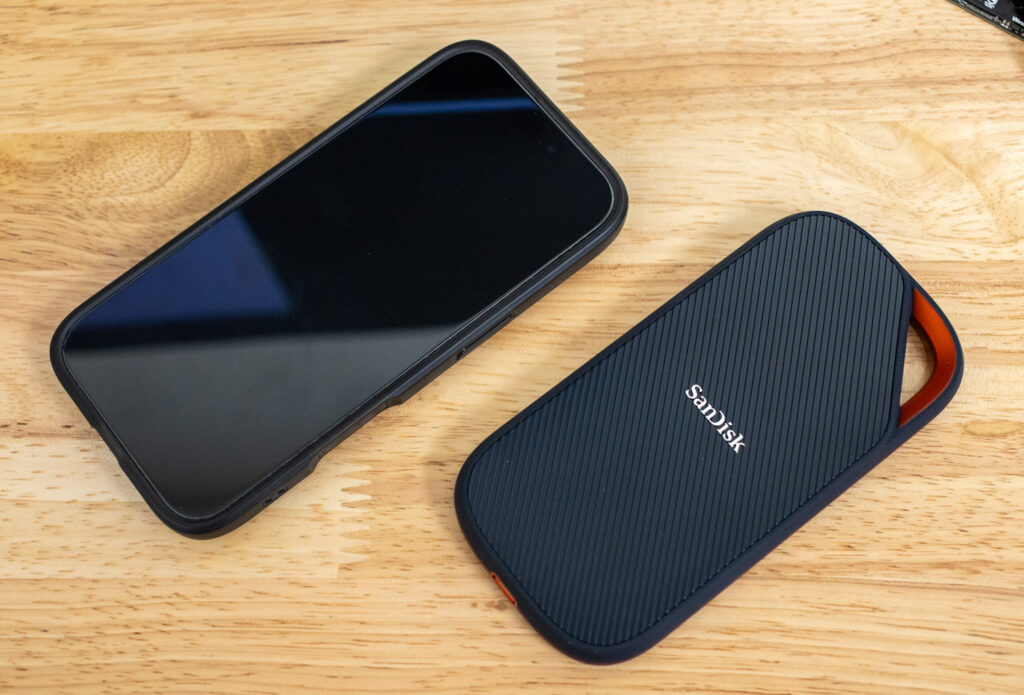
As for the details of its performance profile, SanDisk claims that it can reach up to 3,800MB/s read and 3,700MB/s write speeds under ideal conditions. This puts it in the same performance tier as some Thunderbolt 3 and 4 SSDs, but with broader host compatibility. To achieve those peak numbers, you’ll need a fully compliant USB4 or Thunderbolt 4 port; otherwise, it will default to USB 3.2 Gen 2×2 or lower speeds depending on the system it’s connected to.
The Extreme PRO is also compatible with macOS, Windows, Xbox Series X|S, and PS5, making it a solid option for console gaming storage or cross-platform media use. This will appeal to a broader range of users, not just creative professionals.
The SanDisk Extreme PRO with USB4 comes backed by a 5-year warranty. The 2TB model costs $279, and the 4TB model costs $429 at the time of this review on Amazon (affiliate link). For this review, we will be looking at the 2TB model. While they have the same specifications, larger capacity models often benefit from increased parallelism and larger cache sizes, leading to slightly better sustained performance and endurance under heavy workloads. That said, real-world speed differences between capacities will be minimal for most users in everyday tasks.
SanDisk Extreme PRO with USB4 Specifications
| Specification | Details |
| Form Factor | Portable SSD |
| Capacity Options | 2TB, 4TB |
| Interface | USB4 Gen 3×2 (40Gbps) |
| Max Read Speed | Up to 3,800MB/s |
| Max Write Speed | Up to 3,700MB/s |
| Dimensions | 5.51″ x 2.70″ x 0.47″ (140.00 x 68.70 x 11.90 mm) |
| Weight | 0.38 lbs (172g) |
| Drop Protection | Up to 2 meters |
| Water/Dust Resistance | IP65 |
| Operating Temp | 5°C to 45°C |
| Storage Temp | -20°C to 85°C |
| Compatibility | Windows 10+, macOS 14+, Xbox Series X |
| In the Box | SSD, USB-C to USB-C cable, Quick Start Guide |
| Warranty | 5-Year Limited Warranty |
SanDisk Extreme PRO with USB4 Design and Build
The Extreme PRO USB4 SSD is noticeably larger than SanDisk’s previous portable models, as seen in the image below. Measuring 5.51 x 2.70 x 0.47 inches and weighing 172 grams, it’s very bulky for a modern portable drive and may be less convenient for users who prioritize ultra-compact gear. However, the increased size allows for higher-performance components, improved thermal dissipation, and a reinforced enclosure contributing to its IP65 rating and overall durability. For users focused on sustained speed and ruggedness, the tradeoff in size might be worth it.
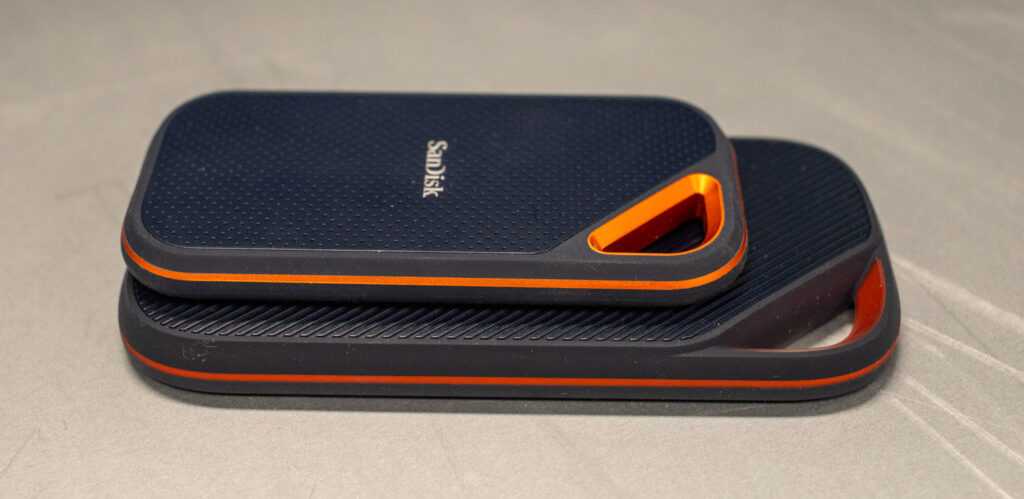
The enclosure features a forged aluminum core wrapped in a textured silicone shell, improving impact resistance while helping with grip and thermal dissipation. SanDisk rates the drive for IP65 water and dust resistance and drop protection up to 2 meters, meaning it’s designed to handle knocks, splashes, and general outdoor use. The USB-C port is recessed slightly for added durability when carried or packed away. Overall, the build quality aligns with what you’d expect from SanDisk’s pro-level, high-speed external SSD.
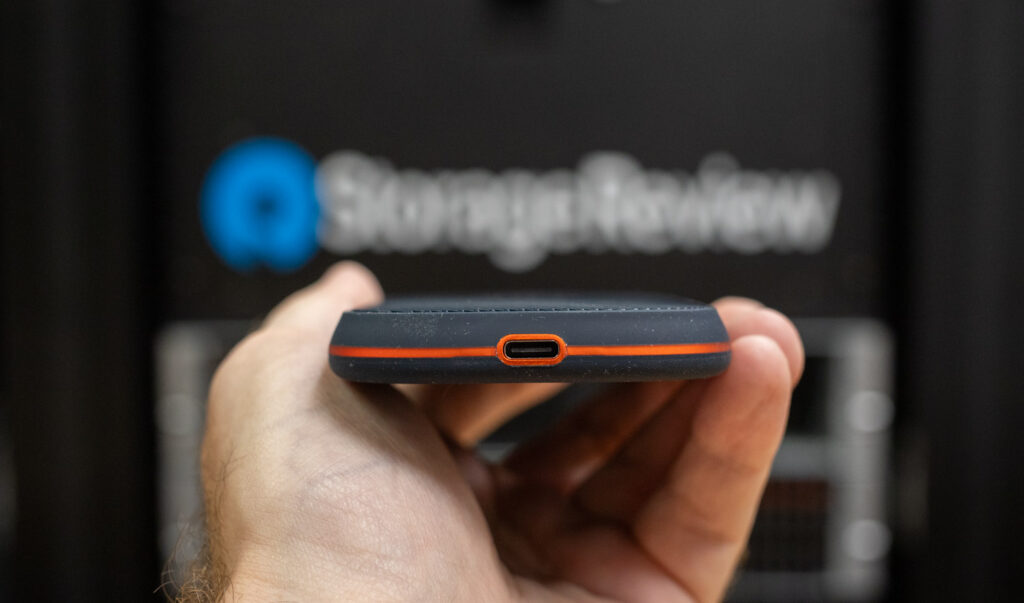
While the drive ships with a USB-C to USB-C cable, it doesn’t include a USB-A adapter. That’s not too surprising given the target audience for this model, but it’s something to keep in mind if you’re still working with legacy ports. The drive is also fully bus-powered, so no external power supply is needed, making it ideal for mobile workflows.
SanDisk Extreme PRO with USB4 Performance
Let’s look at how the new SanDisk Extreme PRO handles transfer speeds using the Blackmagic Disk Speed Test and IOMeter benchmarks in single-queue and four-queue configurations.
We don’t have another USB4 drive available for a direct comparison, still, we’ll show how it measures up against USB 3.2 Gen 2×2 external drives to highlight the performance gains from the new generation.
Here’s the high-performance test rig we used for benchmarking. Prior drives were tested on a Lenovo ThinkStation P520:
- CPU: AMD Ryzen 7 9800X3D
- Motherboard: Asus ROG Crosshair X870E Hero
- RAM: G.SKILL Trident Z5 Royal Series DDR5-6000 (2x16GB)
- GPU: NVIDIA GeForce RTX 4090
- OS: Windows 11 Pro, Ubuntu 22.04 Server
First up is the usual Blackmagic Disk Speed test, which gauges the real-world performance of external SSDs.
Despite being rated for up to 3,800MB/s read and 3,700MB/s write, the SanDisk Extreme PRO USB4 peaked at 3,172.3MB/s read and 2,863.6MB/s write in the Blackmagic Test. While it doesn’t quite hit the theoretical maximums (which almost always happens when benching drives), these are still strong real-world results that put it well ahead of the USB 3.2 Gen 2×2 drives tested. Competing models like the Lexar SL500, TEAMGROUP PD20, and Crucial X10 Pro all hovered around 1,600MB/s to 1,800MB/s for both read and write, showing a clear generational leap in throughput for users with USB4-capable systems.
| Disk Speed Test | SanDisk Extreme PRO with USB4 | Lexar SL500 | TEAMGROUP PD20 | Crucial X10 Pro | Samsung T9 |
| Write | 2,863.6MB/s | 1,633.9MB/s | 1,633.5MB/s | 1,564.0MB/s | 1,581.6MB/s |
| Read | 3,172.3MB/s | 1,780.1MB/s | 1,800.7MB/s | 1,723.1MB/s | 1,566.0MB/s |
IOMeter 1 Queue
The next test is the single-queue IOMeter test, which examines sequential and random read/write performance under a lighter load. The speeds here will be close to those in the BlackMagic test on the Sequential 2MB read and write portions, but we should see some differences in the 4-queue portion.
In the single-threaded IOMeter test, the SanDisk Extreme PRO USB4 reached 2,993MB/s sequential read and 2,309MB/s write speeds, well ahead of all USB 3.2 Gen 2×2 competitors, which generally hovered around 1,300MB/s to 1,800MB/s. Random 2MB workloads also showed the SanDisk drive maintaining a strong edge, with reads at 2,864MB/s and writes at 2,291MB/s, which is nearly double the performance of the closest competitor in some cases.
Interestingly, the 4K random performance told a slightly different story. While the Extreme PRO USB4 led in read IOPS at 14,828 (roughly triple what the others delivered), it trailed significantly in 4K write performance at just 4,959 IOPS. Drives like the Lexar SL500 and TEAMGROUP PD20 posted much higher write IOPS in this category, indicating that the SanDisk may be optimized more for large-block sequential or random throughput than small-block random writes under light load.
Overall, this mix of results shows the SanDisk drive’s strength in high-bandwidth tasks, but also points to a tradeoff in small random write responsiveness under single-threaded conditions.
| IOMeter (1 Thread) |
SanDisk Extreme PRO with USB4 | Lexar SL500 | TEAMGROUP PD20 | Crucial X10 Pro | Samsung T9 |
| Seq 2MB Write | 2,309.62MB/s | 1427.0MB/s | 1,497.28MB/s | 1,273.3MB/s | 1,284MB/s |
| Seq 2MB Read | 2,993.11MB/s | 1705.97MB/s | 1,799.88MB/s | 1,591.5MB/s | 1,355MB/s |
| Random 2MB Write | 2,290.75MB/s | 1320.19MB/s | 1,359.07MB/s | 1,104.1MB/s | 1,355MB/s |
| Random 2MB Read | 2,864.66MB/s | 1336.21MB/s | 1,439.38MB/s | 1,242.8MB/s | 1,117MB/s |
| Random 4K Write | 4,959 IOPS | 23,181 IOPS | 21,381 IOPS | 19,988 IOPS | 16,643 IOPS |
| Random 4K Read | 14,828 IOPS | 4,901 IOPS | 5,198 IOPS | 4,609 IOPS | 4,441 IOPS |
IOMeter 4 Queue
Our final performance test is the 4-Thread IOMeter test, which better simulates multitasking or heavier workloads.
The SanDisk Extreme PRO USB4 shows off its high-performance USB4 design, especially in sequential and large-block random operations. It reached 3,497MB/s in sequential writes and 3,546MB/s in sequential reads, nearly maxing out its rated specs. Random 2MB performance was similarly strong, with read and write speeds above 3,480MB/s. These results are well ahead of all tested USB 3.2 Gen 2×2 drives, showing the bandwidth advantage USB4 brings in multi-threaded workloads.
However, we see a hit in performance during 4K random writes again. Despite delivering a solid 49,067 IOPS in 4K reads (like in the 1-thread IOMeter, nearly triple its single-threaded score), 4K write performance came in at just 17,315 IOPS. That’s similar to the 4K write result we saw in the 1-thread test, and it stands in contrast to other drives like the Lexar SL500 and Crucial X10 Pro, which maintained much higher 4K write IOPS.
| IOMeter (4 Thread) |
SanDisk Extreme PRO with USB4 | Lexar SL500 | TEAMGROUP PD20 | Crucial X10 Pro | Samsung T9 |
| Seq 2MB Write | 3,497.36MB/s | 1,806.0MB/s | 1,759.06MB/s | 1,736.2MB/s | 1,766MB/s |
| Seq 2MB Read | 3,545.86MB/s | 1,997.36MB/s | 1,505.85MB/s | 1,966.9MB/s | 1,944MB/s |
| Random 2MB Write | 3,482.21MB/s | 1,643.2MB/s | 807.55MB/s | 1,447.9MB/s | 1,493MB/s |
| Random 2MB Read | 3,546.11MB/s | 1,693.18MB/s | 913.25MB/s | 1,863.8MB/s | 1,468MB/s |
| Random 4K Write | 17,315 IOPS | 72,622 IOPS | 63,640 IOPS | 67,206 IOPS | 32,358 IOPS |
| Random 4K Read | 49,067 IOPS | 15623 IOPS | 15,396 IOPS | 15,333 IOPS | 18,925 IOPS |
PCMark 10 Storage (Data Drive)
PCMark 10 simulates real-world tasks like file transfers, app launches, and media access to measure a storage drive’s performance in everyday use. The Data Drive Benchmark focuses on how responsive and efficient a drive is during these common desktop activities.
Here, the SanDisk Extreme PRO USB4 scored 2,585. While certainly not in internal NVMe SSD territory, it’s a solid showing for a portable drive, especially considering the test simulates real-world usage like file transfers, media access, and application launches.
Here’s a full breakdown of the PCMark 10 result:
| Metric | Result |
| Score | 2,585 |
| Bandwidth | 382.62MB/s |
| Average Access Time | 60µs |
| Partition Format | exFAT |
| Drive Capacity | 1862GB (2TB class) |
3DMark Storage Benchmark
Now let’s move on to 3DMark’s Storage Benchmark, which focuses on game-related tasks like loading titles, installing, saving, and recording gameplay.
The SanDisk Extreme PRO USB4 scored 1,370, which lands it well below average compared to the broader pool of tested devices (average noted was 2,246). It’s worth noting that this average includes many high-end internal NVMe SSDs, so external drives like this one are disadvantaged in direct comparison.
Nonetheless, these results align with what we saw in IOMeter: strong performance in read and file copy scenarios, but small file write tasks (e.g., game installs or saves) are not its strong suit.
| Task | Bandwidth | Access Time |
| Average (overall) | 229.23MB/s | 128µs |
| Load Battlefield V | 792.30MB/s | 91µs |
| Load Call of Duty BO4 | 360.10MB/s | 68µs |
| Load Overwatch | 335.71MB/s | 71µs |
| Record Game | 106.87MB/s | 170µs |
| Install Game | 63.11MB/s | 197µs |
| Save Game | 37.41MB/s | 205µs |
| Move Game | 1,376.16MB/s | 192µs |
Conclusion
The SanDisk Extreme PRO USB4 makes a strong case for early adopters looking to take full advantage of the USB4 Gen 3×2 interface. It consistently outperforms USB 3.2 Gen 2×2 drives in sequential and large-block transfers, delivering real-world speeds close to its advertised specs. In our tests, the drive easily handled high-bandwidth tasks like media playback, backups, and file transfers, making it well suited for creative professionals and power users.
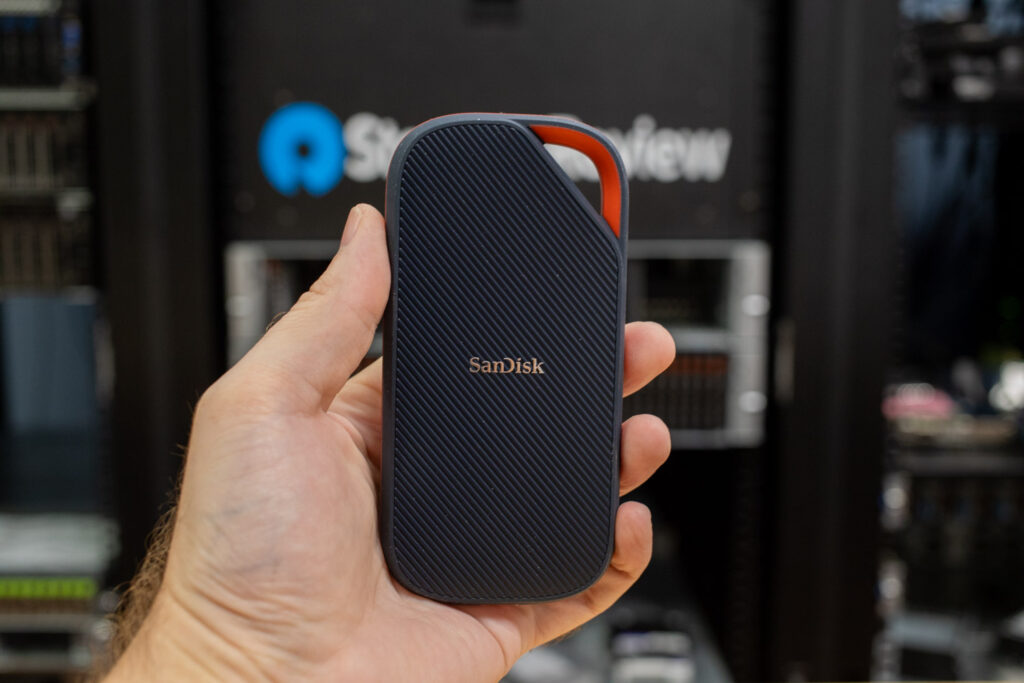
That said, we saw relatively weak 4K random write speeds across both IOMeter workloads, and modest performance in game-related tasks like installs and saves during the 3DMark test. These results suggest the drive is optimized more for throughput than responsiveness in small-file operations. This won’t have much real-world impact for typical use cases like large file transfers, media editing, or game loading. However, tasks that involve frequent small file writes (such as software installs, syncing countless small files, or running portable apps) may not feel as responsive compared to high-IOPS alternatives.
Still, with its rugged build, USB4 compatibility, and up to 4TB capacity, the Extreme PRO USB4 is a compelling portable solution for those prioritizing speed and durability. It has a much larger footprint than most portable SSDs. The added weight might be a drawback for users who value ultra-compact gear; however, the tradeoff might be justified for heavy file movers, video editors, and gamers with large libraries. Just ensure your system supports USB4 or Thunderbolt 4 to fully utilize its performance.
SanDisk Drives at Amazon (affiliate link)




 Amazon
Amazon